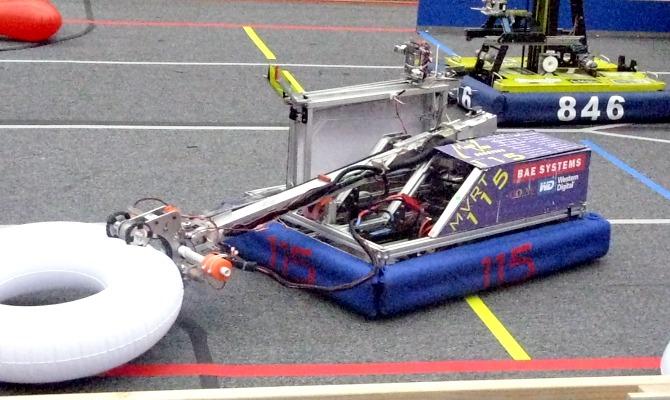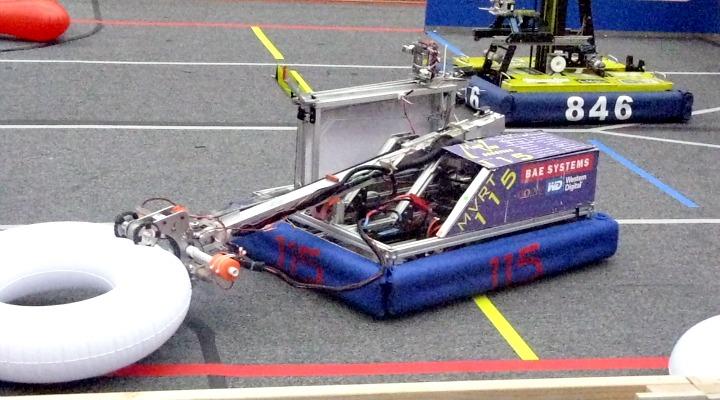
On Oct. 21 and 22, the MVHS Robotics Team faced 34 other high school teams at Archibishop Mitty High School during CalGames, an annual heated regional competition. After ranking 15th during the qualification rounds, MVRT was eliminated during the quarter finals.
Qualification matches lasted from 6:00 p.m. to 9:00 p.m. on Oct. 21 and then continued into Oct. 22 from 8:00 am to 2:00 pm before elimination matches. The final winners were teams from Bellarmine College Preparatory, Mountain View High School, and the Fremont Unified School District team.
Although the two main competitions and championships are held earlier in the year in March and April, CalGames is one of the few off-season competitions that allows participants to enjoy the last time they compete with their respective robots before constructing new ones for the next year.
“[Competing] is a lot of fun because you can see your hard work being put out there and finally all the work you put into it is being awarded,” said Director of Engineering senior Nupur Garg.
Games played by the robots change annually, and are created by the organizers, a group called For Inspiration and Recognition in Science and Technology (FIRST). The 2011 game is called Logomotion, in which human players control robots grouped into alliances of three to hook large inflatable shapes on pegs within a designated time limit. A team will receive a doubled score for a row with inflatable shapes placed in the order of the FIRST logo (red triangle, white circle, blue square). Towards the end of the round, robots can deploy minibots — smaller robots that are separate from the main structure — which climb one of four vertical poles in the middle of the field to receive up to 20 points.
For MVRT, the qualification rounds did not look favorable. Although there were numerous attempts to adjust the robot’s functionality in between games, El Toro 15 consistently failed to launch its minibot successfully. By the afternoon of Oct. 22, after persistent tests and minor tweaks, the Robotics team was finally able to deploy their first-ever minibot in competition during their last qualification match. The minibot launch was the fastest in the round and earned MVRT the full 20 points.
“Since the actual competition [in April], we have improved our minibot release, which is another component of the game challenge,” said Garg. “We successfully achieved that during CalGames in the final few matches, which was a great accomplishment for us.”
MVRT mentor Mauri Laitinen, who has guided MVRT for seven years, was particularly pleased with the team’s performance during CalGames.
“My expectation was to put in a decent performance and I think that we did better than that, so yes, they beat my expectations,” Laitenen said. “We had problems with the robot last year and we lost a lot of seniors, so the team has had to take time to gel again. I think they did that in this competition; they started working more like a team.”
El Toro 15 successfully deployed yet another minibot during the first match but the difference in scores could not be repaired. Even so, MVRT, led by officer junior Joyce Yan, cheered enthusiastically for all members of their alliance. Laitinen hopes that Robotics will have left an impression on the first-time competitors, particularly the freshmen.
“[Freshmen] just don’t know what [Robotics] is about,” Laitinen said. “It’s only by watching a competition like that that they understand what we’re doing; they understand the interest in robotics and seeing things work.”
Nevertheless, a few freshmen that did attend CalGames had their eyes opened to the competitive side of robotics. Freshmen Tyler Pennebaker was one of them — and while he was a runner and electrical assistant in the pit, he hopes to become more involved after seeing what MVRT does.
“A long time ago I would always watch TV robots and stuff. When i just heard about it from Mr. Shinta and from other members and saw the demo, I just wanted to do it because it looked really fun,” Pennebaker said. “In later years l will try to become a better electrical [engineer] and maybe even help out with both electrical and mechanical [aspects of robotics].”
The majority of the other forty participating members were veterans. Though they had foreseen their results after their weak start, MVRT continued to stay optimistic as they stayed to see the rest of the competing teams through.
“Tired? I’m not tired, everything’s working,” Garg said. “I get tired when things aren’t working.”








